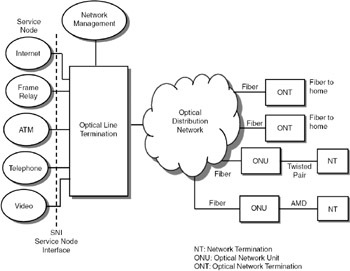14.3 BROADBAND SERVICES TO THE HOMEOFFICE
|
| < Day Day Up > |
|
14.3 BROADBAND SERVICES TO THE HOME/OFFICE
To prsovide broadband services to the home, the office, and so on, the Full Services Access Networks (FSAN) group has been established by network operators to evolve optical access for providing a variety of voice/data/video services. The conceptual architecture for such an access network is shown in Figure 14.7. Work is in progress to define the various standards for deploying such a network.

Figure 14.7: Fiber to home/office.
The architecture consists of an optical distribution system that provides the connectivity to homes/offices, etc. through standard interfaces. The distribution network is a collection of optical fibers and associated interface equipment. In the case of fiber to home or fiber to office, an optical network termination (ONT) will be used to which the end systems can be connected. In places where it is not feasible/economical to use optical fiber at the end, twisted pair or very high speed digital subscriber line (VDSL) can be used. The optical network unit (ONU) provides the interface between the network termination (NT) and the distribution network. The services supported can be based on a variety of networks such as Asynchronous Transfer Mode (ATM), Frame Relay, Internet, PSTN, and so on. The objective of FSAN is very clear: to develop a single worldwide broadband access system.
The Full Services Access Networks (FSAN) group developed a conceptual architecture to provide broadband multimedia services to the home/office using optical fiber as the main transmission medium.
| Note | The objective of the FSAN architecture is to develop a single worldwide broadband access system. In addition to the optical network elements, even the non-optical fiber-based systems can be integrated into this architecture. |
Summary
This chapter presented advances in optical communication systems. Initially, multimode optical fibers were used for transmission, which required regenerators every 10 kilometers. Because regenerators are very costly, multimode optical fiber is used for small distances. With the development of single-mode optical fiber, the data rates increased tremendously. The loss in single-mode fiber is also very low, and hence regenerators are required only for every 40 km. Wave division multiplexing (WDM) and dense WDM (DWDM) facilitate sending multiple wavelengths on the same fiber. Development of optical amplifiers resulted in a lot of cost savings. As a result of all these developments, optical fiber communication at terabits per second data rates is achieved. Standardization activities for optical networks resulted in synchronous optical network (SONET)/synchronous digital hierarchy (SDH) standards. These standards specify the multiplexing hierarchy for transmitting data at rates up to 39.813Gbps, referred to as OC-768. In SONET/SDH, a dual-ring topology is used that provides a very reliable communication infrastructure. A backbone ring can interconnect the major cities in a country, and smaller rings can cover each city. These rings can be interconnected through digital cross connect (DXC) equipment. Now work is in progress to develop standard interfaces to achieve broadband access to homes/offices using optical fiber communication.
References
-
R.Ramaswami. "Optical fiber communication: From Transmission to Networking". IEEE Communications Magazine, 50th Anniversary Issue, May 2002.
-
Y. Maeda et al. "FSAN OAN-WG and Future Issues for Broadband Optical Access Networks". IEEE Communications Magazine, Vol. 31, No. 12, December 2001.
-
http://www.fsanet.net Web site of Full Services Access Networks Group.
-
http://www.ansi.org Web site of American National Standards Institute.
Questions
-
What are the advantages and disadvantages of multimode optical fiber communication systems?
-
What is wave division multiplexing?
-
Explain the architecture of a SONET/SDH ring.
-
What is the function of add-drop multiplexer (ADM)?
-
Explain the conceptual architecture proposed by FSAN.
Exercises
| 1. | Study the specifications of commercially available optical components such as lasers, LEDs, and photodetectors. | |
| 2. | Study the recent developments in DWDM and the data rates achieved. | |
| 3. | Prepare a technical report on Raman amplification. | |
| 4. | Prepare a technical report on the various wavelength bands used in single-mode fiber and the issues involved in making use of these bands (availability of optical components, amplifiers, loss in the cable, etc.). | |
Answers
| 1. | You can get the details from http://www.efiber.net and http://www.fiberalliance.net. |
| 2. | Latest information on DWDM commercial products can be obtained from http://www.cisco.com, http://www.nortelnetworks.com, http://www.ericsson.com, and http://www.siemens.de. |
| 3. | A Raman amplifier is a device that amplifies the optical signals directly. Hence, there is no need to convert the optical signal to electrical signal, amplify it, and reconvert it into optical signal. |
| 4. | Presently C band and L band are used in optical fiber, mainly because of the availability of optical components in these bands. |
Projects
-
Carry out the paper design of a communication system that provides connectivity between all the county seats and state capital of your state. From the county seat to all the major towns in the county, connectivity should be provided. Suggest the design alternatives for mesh and star architecture. High-bandwidth services such as video conferencing, high-speed Internet access, and so forth should be provided.
-
An organization has five branches in a city. Each branch has to be provided with high-speed connectivity for interbranch communication. Propose a solution using fiber optic communication. Study the alternatives in using (a) ring, star, mesh topology; (b) single-mode fiber, multimode fiber; and (c) SONET, WDM. Choose the best alternative based on the following criteria: (a) cost; (b) future expandability in case more branches are opened later; and (c) reliability and availability of the network.
|
| < Day Day Up > |
|
EAN: 2147483647
Pages: 313